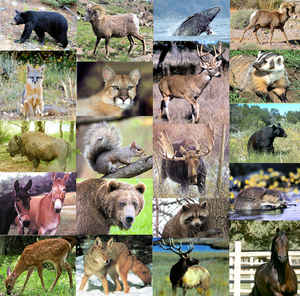Nevada State Animal
Desert Bighorn Sheep

(Ovis canadensis nelsoni)
Adopted in 1973.
The desert bighorn sheep, (Ovis canadensis nelsoni,) is Nevada's state animal. It is a beautiful animal and well-suited for Nevada's mountainous desert country because it can survive for long periods without water. It is smaller than its Rocky Mountain cousin but has a wider spread of horns. The large rams stand about 4 1/2 feet tall and can weigh as much as 175 pounds.
Nevada State Animal: Desert Bighorn Sheep

The desert bighorn sheep, (Ovis canadensis nelsoni,) is a subspecies of bighorn sheep found in the desert Southwest United States and the northern regions of Mexico. The trinomial of this species commemorates the American naturalist Edward William Nelson (1855-1934). The characteristics and behavior of desert bighorn sheep generally follow those of other bighorn sheep, except for adaptation to the lack of water in the desert; bighorn sheep can go for extended periods of time without drinking water.
Characteristics of Nevada Desert Bighorn Sheep

Males 119-127kg; females 53-91 kg. Rams typically measure 160-180 cm from head to tail, while ewes are approximately 150 cm. Bighorn sheep have double-layered skulls shored with struts of bone for battle protection. They also have a broad, massive tendon linking skull and spine to help the head pivot and recoil from blows. Horns may way as much as 14 kg, which is the weight of all the bones in a ram's body. The horns of a female are much smaller and only slightly curved. The horns of a ram can tell much about him such as his age, health, and fighting history. The desert subspecies, (Ovis canadensis nelsoni,) is somewhat smaller and has flatter, wider-spreading horns. The pelage of Ovis canadensis is smooth and composed of an outer coat of brittle guard hairs and short, grey, crimped fleece underfur. The summer coat is a rich, glossy brown but it becomes quite faded by late winter.
Bighorn sheep are very alert and have remarkable eyesight that allows them to judge distances accurately in jumping and locating footholds. They often watch other animals moving at distances of up to a mile away.
Habitat
Desert Bighorn Sheep inhabits alpine meadows, grassy mountain slopes and foothill country in proximity to rugged, rocky cliffs and bluffs. The availability of escape territory in the form of rocky cliffs is important to bighorn sheep survival. If a sheep can reach a rocky outcrop or cliff, it is usually safe from the attack of wolves, coyotes, bears, bobcats and lynx. Bighorn sheep also require drier slopes where the annual snowfall is less than about sixty inches a year, since they cannot paw through deep snow to feed. The winter range usually lies between 2,500-5,000 feet in elevation, while the summer range is between 6,000-8,500 feet.
Behavior
Bighorn sheep are perhaps best known for the head-to-head combat between males. Horn size is a symbol of rank, and the mass of the horns (as much
as 14 kg) is used to a male's best advantage as he smashes into an opponent at speeds of 20 miles per hour. Combat has been observed to last for as
long as 25.5 hours (with approximately 5 clashes an hour) until one of the males conceded. Males do not defend territories but rather engage in battles
over mating access to a particular female. Male dominance status is determined by age as well as horn size, and homosexual activity often occurs in
groups of males with the dominant animal behaving like a courting male and the subordinate playing the role of an estrous female. Although not as well
built for climbing as mountain goats, bighorn sheep zigzag up and down cliff faces with amazing ease. They use ledges only 2 inches wide for footholds,
and bounce from ledge to ledge over spans as wide as 20 feet. They can move over level ground at 30 miles per hour and scramble up mountain slopes
at 15 mph. They also swim freely, despite their massive bulk and weight of their horns.
Most populations undergo seasonal movements, generally using larger upland areas in the summer and concentrating in sheltered valleys during the winter.
Home ranges are quite large, averaging nearly 17 square km.
Bighorn sheep are gregarious, sometimes gathering in herds of over 100 individuals, although small groups of 8-10 are more common. Mature males usually
stay apart from females and young for most of the year in separate bachelor flocks. Young females generally remain in their mother's group (led by
an old ewe), but males depart when two to four years old and joins a group of rams. Young sheep of both sexes learn migratory paths and suitable habitats
from adults in the group.
Bighorn sheep are less vociferous than domestic sheep. The lambs bleat, and the ewes respond with a gutteral "ba." At other times of the year, adults
utter throaty rumbles or "blow" in fright. During the rut, the rams frequently snort loudly.
Nevada Law
The law designating the Desert Bighorn Sheep as the official Nevada state animal is found in the Nevada Revised Statutes, Title 19, Chapter 235, Section 235.070.
TITLE 19-MISCELLANEOUS MATTERS RELATED TO GOVERNMENT AND PUBLIC AFFAIRS
CHAPTER 235 - STATE EMBLEMS; GIFTS AND ENDOWMENTS
MISCELLANEOUS STATE EMBLEMS
SECTION 235.070
NRS 235.070 State animal. The animal known as the Desert Bighorn Sheep (Ovis canadensis nelsoni) is hereby designated as the official state animal
of the State of Nevada.
(Added to NRS by 1973, 315)
Taxonomic Hierarchy: Desert Bighorn Sheep
Kingdom: Animalia
Phylum: Chordata
Class: Mammalia
Order: Artiodactyla
Family: Bovidae
Subfamily: Caprinae
Genus: Ovis
Species: O. canadensis
Subspecies: O. c. nelsoni








